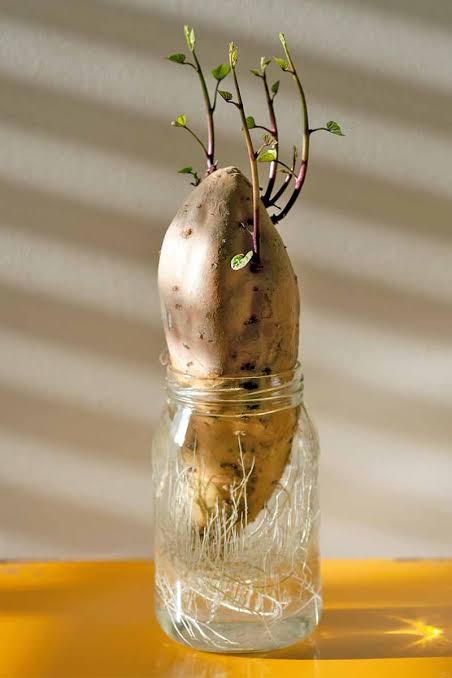Growing sweet potatoes is easier than many gardeners think. The secret is starting with healthy sweet potato slips—those leafy sprouts that grow from a mature sweet potato. Once you know how to plant them correctly, you can enjoy big yields of delicious, homegrown sweet potatoes all season long.This guide walks you through everything: timing, soil, spacing, watering, feeding, and harvesting.🌱 1. What Are Sweet Potato Slips?Sweet potato slips are baby plants grown from a mature sweet potato. They are not seeds or cuttings — they’re sprouts that develop roots and leaves, and you plant those into the soil.Healthy slips = a successful sweet potato harvest.🗓️ 2. Best Time to Plant Sweet Potato SlipsSweet potatoes need warm soil.Plant slips when:Soil temperature is 60–65°F (15–18°C) or warmerAir temperatures stay above 50°F (10°C) at nightRegion timing:Southern USA: April–MayNorthern USA & Canada: Late May–JuneUnited Kingdom: Late May–June, often with black plastic mulch for warmthIf your soil is cold, sweet potatoes will fail — warmth is key.🌾 3. Choose the Right Planting LocationSweet potatoes love:Full sun (6–8 hours minimum)Loose, sandy, well-draining soilWide space to spread their vinesAvoid heavy clay soil unless you amend it deeply with compost and sand.🧺 4. Prepare the Soil for SuccessSweet potatoes grow underground, so soil preparation matters.Improve soil with:Compost or aged manureA bit of sand for drainageOrganic fertilizer (low nitrogen)Ideal soil pH:Slightly acidic (5.8–6.2)Loose soil = bigger, smoother sweet potatoes.🌱 5. How to Plant Sweet Potato Slips (Step-by-Step)👉 Step 1: Water the slipsKeep them moist before planting to prevent transplant shock.👉 Step 2: Dig planting holesMake holes 4–6 inches deep.👉 Step 3: Insert the slipBury the slip up to the top leaves, covering the stem but keeping leaves above soil.This encourages stronger roots and bigger harvests.👉 Step 4: Space them correctlyFor best results:Space slips 12–18 inches apartLeave 3 feet between rowsThis gives vines plenty of room to spread.👉 Step 5: Water deeplyGive each slip a slow, deep watering.This helps roots establish quickly.💧 6. How to Water Sweet Potato SlipsSweet potatoes need consistent moisture, especially during early growth.Watering tips:Keep soil evenly moist for the first 2–3 weeksReduce watering once vines spreadDeep watering is better than frequent shallow wateringAvoid overwatering — soggy soil leads to rotSweet potatoes are drought-tolerant once established.🌿 7. Feeding Sweet PotatoesUse a fertilizer that is:Low in nitrogen (too much = leaves, no tubers)High in potassium and phosphorusGood choices:Bone mealWood ash (light application)Organic vegetable fertilizer (balanced but low nitrogen)Feed once at planting and again mid-season.🌞 8. Train the Vines (Optional but Helpful!)Sweet potato vines will sprawl everywhere.You can:Redirect them into rowsMulch around the vinesUse black plastic to warm soil and reduce weedsThis encourages bigger roots underneath the vine nodes.🧹 9. Mulching Sweet PotatoesMulch helps with moisture, weed control, and warmth.Best mulch types:StrawWood chipsShredded leavesBlack plastic for cooler climatesKeep mulch a few inches away from the base of the plant.🐛 10. Protect From PestsCommon pests:WirewormsSweet potato weevilsSlugsDeer and rabbitsSolutions:Use floating row covers early in the seasonMulch with cedar chips to deter insectsPick slugs at night or use trapsFence out deer and rabbitsHealthy vines naturally resist most pests.🕒 11. When & How to Harvest Sweet PotatoesSweet potatoes are ready 90–120 days after planting.Signs they’re ready:Leaves start turning yellowFirst frost is approachingVines stop vigorous growthHow to harvest:Use a garden forkLoosen soil gentlyLift the potatoes carefully — they bruise easilyBrush soil off (don’t wash)Freshly dug sweet potatoes are fragile — handle with care.🔥 12. Cure Sweet Potatoes for Maximum FlavorCuring transforms them from starchy to sweet.Cure by:Keeping them at 80–85°F (26–29°C)High humidity7–10 daysAfter curing, store at:55–60°F (13–16°C)Dry, dark placeProper curing = sweeter, longer-lasting sweet potatoes.🌟 Conclusion: Your Ultimate Guide to How to Plant Sweet Potato SlipsPlanting sweet potato slips is simple once you understand the basics:Warm soilFull sunMoisture early onProper spacingLoose, fertile soilGentle harvesting and curingWith this ultimate guide on how to plant sweet potato slips, you’ll enjoy a big, delicious harvest—perfect for baking, roasting, or making sweet potato fries.

